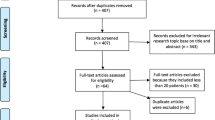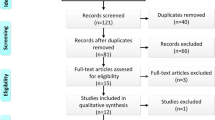Abstract
Purpose
Bariatric surgery is a treatment for morbid obesity. Different surgical procedures have been described in order to obtain excess weight loss (EWL), but currently laparoscopic sleeve gastrectomy is the most commonly performed procedure throughout the world. Reducing abdominal wall trauma and increasing the aesthetic result are important goals for all bariatric surgeons. We conducted a randomized, controlled trial in order to assess if the three-trocar sleeve gastrectomy can be safely carried out or should be abandoned.
Materials and Methods
From September 2016 to February 2017, 90 patients were enrolled in our trial. Each patients was evaluated by a multidisciplinary team before surgery. Two groups were created after application of the inclusion and exclusion criteria. The primary endpoint was to define the features of early post-operative complications of patients in group 1 (the three-trocar technique—the experimental group) compared to group 2 (five-trocar technique—the control group). The secondary endpoints were to evaluate any differences between the two groups concerning post-operative pain and patients’ satisfaction with the aesthetic results.
Results
There was no difference between the two groups concerning age, sex distribution, weight, and BMI. The rate of co-morbidities was similar in both groups. Operative time was inferior in the control group, but patient satisfaction was better in the three-trocar sleeve gastrectomy group.
Conclusions
The three-trocar sleeve gastrectomy can be safely carried out with a modest increase in operative time, without additional early surgical complications and with a greater patient aesthetic satisfaction.
Trial Registration
researchregistry2386.







Similar content being viewed by others
References
Buchwald H, Avidor Y, Braunwald E, et al. Bariatric surgery: a systematic review and meta-analysis. Jama. 2004;292:1724–37.
Arterburn DE, Olsen MK, Smith VA. Association between bariatric surgery and long-term survival. Jama. 2015;313:62–70.
Booth HP, Khan O, Fildes A. Changing epidemiology of bariatric surgery in the UK: cohort study using primary care electronic health records. Obes Surg. 2016;26:1900–5.
Regan JP, Inabnet WB, Gagner M, et al. Early experience with two-stage laparoscopic Roux-en-Y gastric bypass as an alternative in the super-super obese patient. Obes Surg. 2003;13:861–4.
Czernichow S, Paita M, Nocca D, et al. Current challenges in providing bariatric surgery in France. A nationwide study. Medicine (Baltimore). 2016;95(49):e5314.
Azagury DE, Morton JM. Bariatric surgery: overview of procedures and outcomes. Endocrinol Metab Clin N am. 2016 Sep;45(3):647–56.
Corcelles R, Boules M, Froylich D, et al. Laparoscopic three-port sleeve gastrectomy: a single institution case series. J Laparoendosc Adv Surg Tech a. 2016;26(5):361–5.
Dunford G, Philip S, Kole K. Three-port laparoscopic sleeve gastrectomy: a novel technical modification. Surg Laparosc Endosc Percutan Tech. 2016;26(6):e174–7.
Inaki N. Reduced port laparoscopic gastrectomy: a review, techniques, and perspective. Asian J Endosc Surg. 2015;8(1):1–10.
Nedelcu M, Eddbali I, Noel P. Three-port sleeve gastrectomy: complete posterior approach. SurgObesRelat dis. 2016;12(4):925–7.
Chan A-W, Tetzlaff JM, Altman DG, et al. SPIRIT 2013 Statement: defining standard protocol items for clinical trials. Ann Intern med. 2013;158(3):200–7.
Csendes A, Burdiles P, Burgos AM, et al. Conservative management of anastomotic leaks after 557 open gastric bypasses. Obes Surg. 2005;15:1252–6.
Rosenthal RJ, Diaz AA, Arvidsson D, et al. International sleeve gastrectomy expert panel consensus Statement: best practice guidelines based on experience of > 12,000 cases. Surg Obes Relat dis. 2012;8:8–19.
Author information
Authors and Affiliations
Corresponding author
Ethics declarations
Funding
This research did not receive any specific grant from funding agencies in the public, commercial, or not-for-profit sectors.
Conflict of Interest
The authors declare that they have no conflict of interest.
Rights and permissions
About this article
Cite this article
Consalvo, V., Salsano, V., Sarno, G. et al. Three-Trocar Sleeve Gastrectomy vs Standard Five-Trocar Technique: a Randomized Controlled Trial. OBES SURG 27, 3142–3148 (2017). https://doi.org/10.1007/s11695-017-2760-0
Published:
Issue Date:
DOI: https://doi.org/10.1007/s11695-017-2760-0




